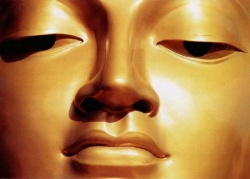Mahinda
Mahinda was the son of King Aśoka, the greatest of all Buddhist rulers.
After the Third Council, held in Patna, missionary monks were sent to the different regions of India and beyond.
Mahinda was selected to lead a group of monks to the island of Sri Lanka.
Tradition says he flew to the Island, although evidence shows that he did missionary work in south India before going to Sri Lanka in about 246 BCE.
After his arrival, he met and converted the king and his court and gradually the whole country became Buddhist.
Mahinda died in 202 BCE and after his cremation his ashes were enshrined in several stūpas erected around the Island.
Mahinda’s arrival in Sri Lanka is celebrated with much enthusiasm in that country on the full moon of June-July.
Mahinda (Sanskrit: महेन्द्र; Mahendra) (born 3rd century BCE in Magadha, now in Bihar, India) was a Buddhist monk depicted in Buddhist sources as bringing Buddhism to Sri Lanka.
He was the first-born son of the Mauryan Emperor Ashoka and his wife Empress Vidisha Devi and the older fratenal twin of Sanghamitra.
He was also the heir apparent to the throne of Magadha. Ashoka named him Mahendra, meaning "conquer of the world". But Mahendra, inspired by his mother became a Buddhist monk.
Historical sources
The Dipavamsa and the Mahavamsa, Sri Lanka's two great religious chronicles, contain accounts of Mahinda travelling to Sri Lanka and converting King Devanampiyatissa. These are the primary sources for accounts of his life and deeds.
Inscriptions and literary references also establish that Buddhism became prevalent in Sri Lanka around the 3rd century BCE, the period when Mahinda lived.
Mahinda grew up at Vidisha, the residence of his mother and became a monk at the age of 20 with Moggaliputta-Tissa, his father's spiritual teacher, guiding him and was well-versed with the Tripitaka.
Mahinda together with fellow monks Itthiya, Uttiya, Sambala, Bhaddasala and Saamanera Sumana(who was the son of Sanghamitta) were sent to Sri Lanka to spread Buddhism, following the Third Buddhist Council, upon the recommendation of Moggaliputta-Tissa.
He was also accompanied by a lay disciple Bhankuka, who was a maternal grandson of his aunt.
Though Ashoka wanted his prodigal eldest son Mahendra to succeed him and made several attempts to bring him out of renunciation, due to the orthodox Hindu community's refusal to accept a Buddhist Crown Prince from a Vaishya mother as well as Majhendra's own lack of enthusiasm to take over an empire, he gave up.
Though texts describe Mahendra's motive behind leaving for Sri lanka is described to be spiritual, historians have argued that it was more of a political motive.
Ashoka had feared that Mahendra would be killed just like Sushima, so in order to keep him safe and to avoid any succession war, he sent to Sri Lanka. The party left from Vedasagiri vihara, believed to be modern day Sanchi.
Mahavamsa and Dipavamsa, the chronicles of Sri Lanka, record the arrival of the party on the full moon of Jettha, a national festival at the time. At the time, King Devanampiyatissa was partaking in a hunting expedition in the Mihintale hills.
It is said that Asoka and Devanampiyatissa were previously acquainted and on good terms, having exchanged royal gifts upon their respective ascensions to the throne. Upon meeting the shaven-headed monks Devanampiyatissa was taken aback by their appearance and inquired as to who they were.
After exchanging greetings, Mahinda preached the Chulahatthipadopama Sutra, and the royal hunting party converted to Buddhism.
The party was subsequently invited to Anuradhapura, the seat of the throne for a royal reception and to give further dharma talks.
Mahinda subsequently gave two public talks sanctioned by Devanampiyatissa, in the Royal Hall and in the Nandana garden in the Royal Park, leading to the start of the public embrace of Buddhism in Sri Lanka.
The royal park Mahamegha was then set aside as the residence for Mahinda's party, and in later times became the Mahavihara, the earliest centre of Buddhist culture and scholarship Sri Lanka.
The Chetiyagirivihara monastery was then established in Mihintale.
Mahinda then sent for his sister Sanghamitta from Magadha, who was a nun, to start a female Buddhist order after local women had expressed a desire to join the Sangha.
Mahinda also arrainged for a bodhi sapling from the original tree in Bodh Gaya to be sent to Sri Lanka, where it was planted in the grounds of the Mahavihara and is still visible today.
After a month spent delivering discourses to Sri Lankans who had ventured to the capital, Mahinda retreated to Mihintale to spend the vassa during the monsoon season.
As a result, a second royal funded monastery was built there. Later, Mahinda organised for a stupa to be constructed, and a part of the bodily relics of Gautama Buddha were transferred from the Maurya Empire to Sri Lanka.
Mahinda then had Arittha, Devanampiyatissa's nephew, a bhikkhu, to expound the Vinaya monastic code of discipline to further Buddhism in Sri Lanka.
Mahinda outlived Devanampiyatissa, and died at the age of 80 in Sri Lanka. King Uttiya, who succeeded his brother, organized a state funeral for Mahinda and constructed a stupa to house his relics at Mihintale.
Significance and legacy
The 20th century Sri Lankan monk Walpola Rahula described Mahinda as "the father of Sinhalese literature" as he had translated and written commentary for the Tripitaka in Sinhalese, turning it into a literary language.
He was also credited with introducing the culture of the Mauryan empire to the island, along with its architecture.
Mihintale, the mountain where Mahinda supposedly first encountered King Devanampiyatissa and the site of his funerary stupa, is an important pilgrimage site in Sri Lanka.
Pilgrimages are traditionally undertaken in the month of June (Poson in the old Sinhala calendar), when Mahinda is believed to have arrived in Sri Lanka on the full-moon night of the month, a traditional time for religious observances in Theravada Buddhism

